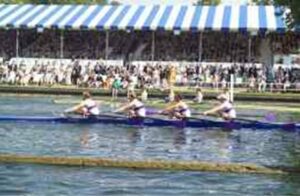
In 1839 first Henley Regatta was held for a single day. In March that year Captain Edmund Gardiner proposed Henley’s annual regatta, to be managed under judicious and respectable management. That year the first Henley Regatta was held over a single day, its success meant that next year it ran for two, it kept extending until today it runs for five days.
In its first years it was so successful that by 1851 it had received the royal seal of approval, and Prince Albert agreed to become the patron. Since his death every reigning monarch has become the patron of the regatta.
However, this is really a story about the fate of amateurism, you see, originally only amateur oarsmen could enter, which produced no end of arguments, which led to the committee, in 1879, having to produce a formal definition of amateurism, which was:
No person shall be considered an amateur oarsman or sculler, or coxswain:
- Who has ever competed in any open competition for a stake, money, or entrance fee.
- Who has ever competed with or against a professional for any prize.
- Who has ever taught, pursued or assisted in the practice of athletic exercises of any kind as a means of gaining a livelihood.
- Who has been employed in or about boats for money or wages.
- Who is or has been by trade or employment for wages a mechanic, artisan or labourer.
Did it work?
Well, it was a bit draconian, especially as within five years the committee decided that even overseas oarsmen had to meet these criteria. They went even further two years later when they added the words anyone “engaged in any menial activity”.
Of course, inevitably this caused problems as many of the competitors came from abroad where different countries had different definitions of amateur. Even in this country it led to the formation of the National Amateur Rowing Association, and they used a more relaxed definition.
It led to many incidents.
The most Famous incident
Probably the most famous being when in 1920 the committee excluded a future Olympic champion John B. Kelly Sr. Why, because horror of horrors he had been apprenticed to a bricklayer! That wasn’t his only crime in their eyes, he was also a member of the Vesper Boat Club, and would you believe that the club had raised the money to pay for their trip through public donations! How dreadful, as in the eyes of the committee it showed that they were professionals.
John B Kelly
He was an interesting man, we mostly remember him for his famous daughter the film star, Grace Kelly, who married Prince Rainer of Monaco. Yes, he started as a bricklayer, but he was a different sort of man as he built a prosperous a bricklaying company, and, to make certain he was paid, he had a novel system. Now this I like. He had a novel way of making certain he got paid by the property developers, who just like today, were notoriously as bad payers. Therefore, in each chimney they built he would add a single pane of glass that would break under the heat of the fire and this pane of glass would stay there until he was paid. It worked, for the obvious reason that if he wasn’t paid, the new owners of the property would soon be complaining to the developer of smoke inside their home! It was effective and he soon became a millionaire.
Of course, his rejection at Henley was great for his business, as he made certain the papers in Philadelphia, New York, and Philadelphia reported it. The result was his business grew, and he became very popular with Americans, who were soon claiming that he was only rejected because the English couldn’t stand an American winning the Diamonds. This all helped him to become a millionaire.
Then, of course, at that year’s Olympics he won a gold medal and there is a lovely story that after his victory, he made a gift of his racing cap to the patron of Henley Regatta, King George V, along with a note: “Greetings from a bricklayer”.
In the end:
Eventually, when in 1936, the Australian national eight was excluded, this time on the excuse that the crew was made up of policemen, who the committee deemed to be ‘manual workers’, it was the final straw. There was uproar and therefore, for the 1938 regatta the Stewards changed the rules.
However, would you believe that it still took until December 1998 for the Stewards to remove all references to amateurism from their rules?
Isn’t history fun?
10 questions to discuss:
- How did the Henley Regatta evolve from a one-day event to a five-day event?
- What role did Prince Albert and subsequent monarchs play in the history of the Regatta?
- Explain the original definition of “amateurism” used by the Regatta committee.
- Why did the committee’s strict definition of amateurism cause problems?
- Describe the incident involving John B. Kelly Sr. and how it highlighted the issues with amateurism.
- Explain John B. Kelly Sr.’s unique way of ensuring payment for his bricklaying work.
- How did Kelly’s Olympic victory and subsequent actions challenge the Regatta’s stance on amateurism?
- What events led to the eventual abolishment of the amateurism rules in 1998?
- Do you think the original concept of amateurism in sports has any merit today? Why or why not?
- Discuss the wider social and cultural significance of the Henley Regatta’s evolving definition of “amateurism”.
These questions go beyond a simple summary of the text and encourage critical thinking, analysis, and personal reflection on the historical and social implications of the changing definitions of amateurism in sports.
For more on this:
http://www.armchairanglophile.com/royal-regatta/

